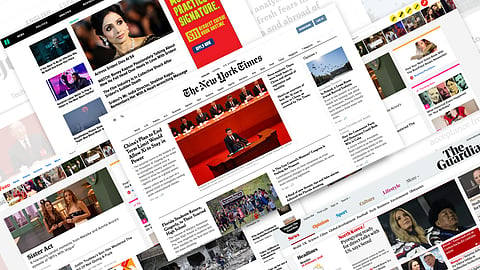Death of the Homepage
Story pages are the ones that are widely shared and go viral. Hence it makes sense to design and optimise them first, before focusing on the homepage. No one really shares a publishers homepage.
Are news publisher home pages dead? Are they even relevant in the current times when a majority of the traffic comes in from search, social and deep social networks?
News used to be a destination, and you would go find it in your driveway and in your browser. Now you’re the destination, and news articles come at you -they find you
Derek Thompson, from the Atlantic
Ever since the leaked report from NYT went public in 2014, the death of the homepage has been a contentious point of discussion among news publishers. However, we are still seeing a lot of publishers invest heavily in designing, maintaining and curating the homepage for their users. Why would someone invest a significant amount of money and resources on the homepage, if the common belief of the death of the homepage were true? Let's analyse this in a bit more depth.
Advantages of a News Homepage
- Branding - For most publishers, the homepage is their brand identity. This is where the design process starts - the color palette, fonts, big splash images or thumbnails and text, placement of ads and widgets, menus and sections, and the list goes on. No two publishers would want their homepages looking similar and hence everyone invests significant amounts of money in hiring agencies and experts to help them design differentiated and visually appealing home pages.
- Editorial Curation - Almost every digital news publisher manually curates their homepage for their audience. This is done multiple times every day to ensure the latest and the most popular news is available right on top. The front page is our branding opportunity. It’s a rebranding opportunity, too, a way to demonstrate intelligence, taste and yes, snicker away! -even beauty,” -- Nick Denton (Gawker CEO)
- Audience Loyalty - Though the home pages get much less traffic compared to the articles pages, the average user landing on the homepage seems to read a lot more articles compared to users who come in via the article pages. Also, during significant events (election results, terrorist attacks, Olympics, stock markets etc.) users flock to the home pages of their favorite news sites to get the latest news about these events.
Going with the Data
At Quintype, we work with multiple publishers across industries - from politics and financial news to travel and e-commerce. The traffic on the homepages of publishers varies between 8-15% of their total traffic i.e. on average 1 in about 8 visitors on these properties visit the homepage. The rest of the traffic comes in directly to the article pages from various other sources - social, search, news aggregators, paid traffic, newsletters and push notifications. These users, termed as “digital grazers”, consume just 1 or 2 articles on the site and move on, to other sites or back to where they came in from.
Yet, we see a lot of publishers spending a lot more time and money brainstorming ideas for the home page design. At Quintype, we encourage our publishers to go with what the data is telling you i.e. focus on creating unique content and optimise the design and performance of the article pages first (90+ on pagespeed, AMP enabled, aggressive caching etc). When you have this sorted, focus on getting the homepage right.
Designing and working on the article pages before the homepage is easier said than done. Almost every publisher we've spoken to falls into the analysis-paralysis trap of designing the homepage first, and by the time they start looking at the article pages, the team is exhausted and the money is running out.
If you are a small to medium publisher (i.e. lesser than 5 mn monthly uniques), we would encourage you to focus on the creating great content and building the audience first. Pick any of the 1000+ homepage templates that are freely available and customise it rather than start from scratch.
Optimise your Article Pages
Optimise the article pages as much as you possibly can, and some more! A few tips -
- Google page speed is a great tool to get a quick view of the issues on your article pages. Try to keep the top of the article pages loading within 1-2 seconds with a page speed score of 90+. You should optimize by loading only the content above the fold and then fetching more content as the user scrolls.
- Create multiple templates for article pages -Text story, Photo stories, Video stories, Live Blogs, Breaking News, Infographics etc. This would break the monotony of design and keep the users more engaged on the site.
- Cache aggressively -Most of the publisher sites have a read/write ratio of over 10000:1. Articles over a day old are seldom changed. These can be cached for weeks/months and delivered at lightning speeds via the CDN.
- AMP and structured data - Google is your friend if you feed it well! Ensure that all the article pages have an AMP version and all the structured data has the appropriate fields as required. While these practices significantly enhance your SEO, AMP pages are served extremely fast from Google's servers and hence helps retain the users.
Once the article pages are optimised as mentioned, publishers should focus on getting the homepage design and branding. A few publishers are also presenting personalised home pages based on audience’s interests, and browsing patterns. At Quintype, we think this is a significant step forward in increasing the audience engagement on the site. We will soon be providing AI-based content recommendations as APIs to our publishers. Do talk to us if you are interested!

